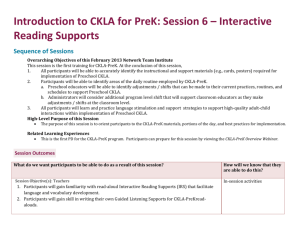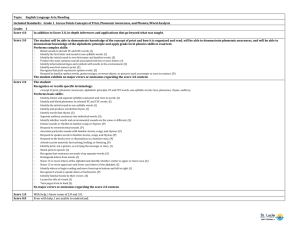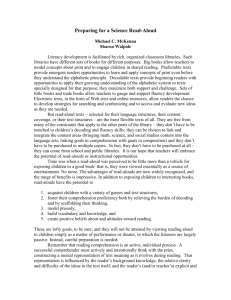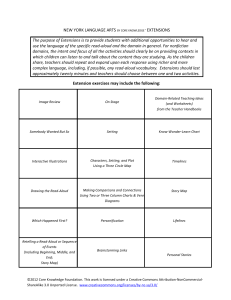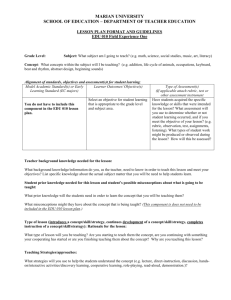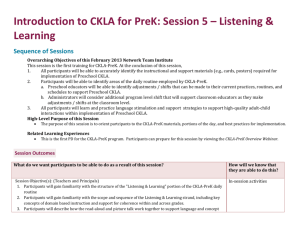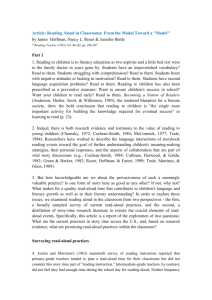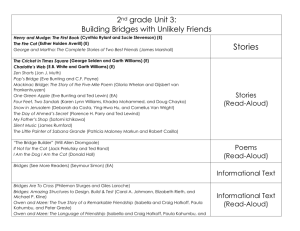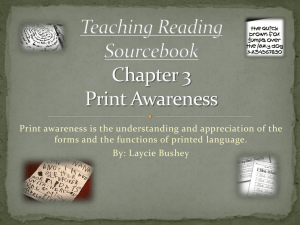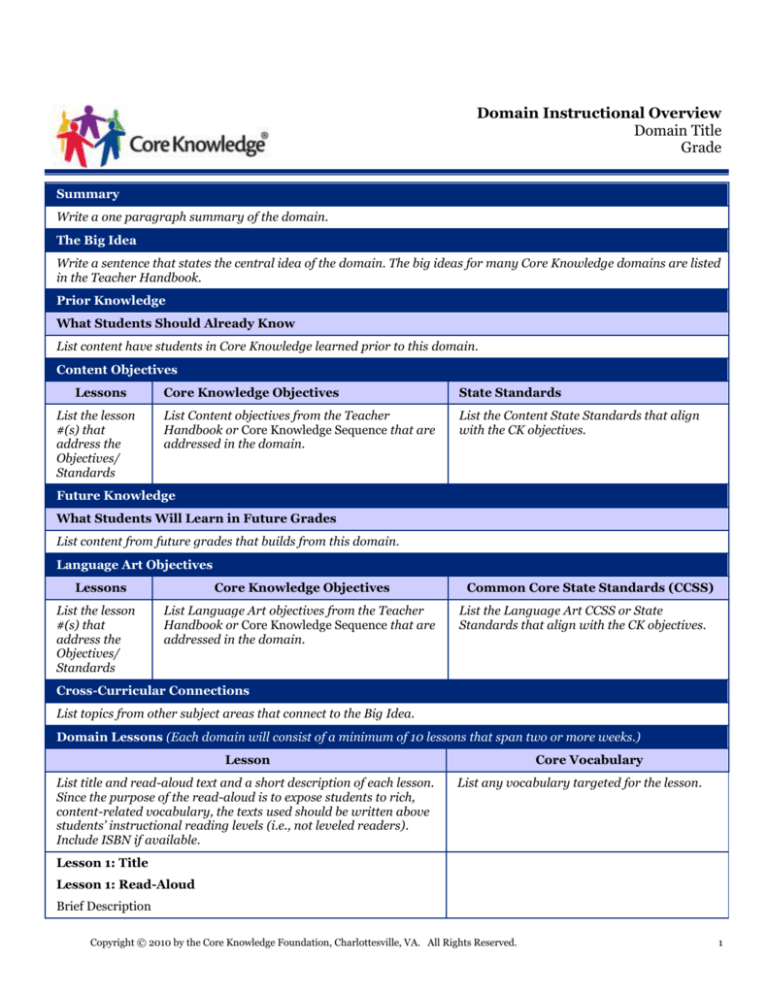
Domain Instructional Overview
Domain Title
Grade
Summary
Write a one paragraph summary of the domain.
The Big Idea
Write a sentence that states the central idea of the domain. The big ideas for many Core Knowledge domains are listed
in the Teacher Handbook.
Prior Knowledge
What Students Should Already Know
List content have students in Core Knowledge learned prior to this domain.
Content Objectives
Lessons
List the lesson
#(s) that
address the
Objectives/
Standards
Core Knowledge Objectives
State Standards
List Content objectives from the Teacher
Handbook or Core Knowledge Sequence that are
addressed in the domain.
List the Content State Standards that align
with the CK objectives.
Future Knowledge
What Students Will Learn in Future Grades
List content from future grades that builds from this domain.
Language Art Objectives
Lessons
List the lesson
#(s) that
address the
Objectives/
Standards
Core Knowledge Objectives
List Language Art objectives from the Teacher
Handbook or Core Knowledge Sequence that are
addressed in the domain.
Common Core State Standards (CCSS)
List the Language Art CCSS or State
Standards that align with the CK objectives.
Cross-Curricular Connections
List topics from other subject areas that connect to the Big Idea.
Domain Lessons (Each domain will consist of a minimum of 10 lessons that span two or more weeks.)
Lesson
List title and read-aloud text and a short description of each lesson.
Since the purpose of the read-aloud is to expose students to rich,
content-related vocabulary, the texts used should be written above
students’ instructional reading levels (i.e., not leveled readers).
Include ISBN if available.
Core Vocabulary
List any vocabulary targeted for the lesson.
Lesson 1: Title
Lesson 1: Read-Aloud
Brief Description
Copyright © 2010 by the Core Knowledge Foundation, Charlottesville, VA. All Rights Reserved.
1
Domain Instructional Overview
Domain Title
Grade
Lesson 2: Title
Lesson 2: Read-Aloud
Brief Description
Lesson 3: Title
Lesson 3: Read-Aloud
Brief Description
Lesson4: Title
Lesson4: Read-Aloud
Brief Description
Lesson 5: Title
Lesson 5: Read-Aloud
Brief Description
Lesson 6: Title
Lesson 6: Read-Aloud
Brief Description
Lesson 7: Title
Lesson 7: Read-Aloud
Brief Description
Lesson 8: Title
Lesson 8: Read-Aloud
Brief Description
Lesson 9: Title
Lesson 9: Read-Aloud
Brief Description
Lesson 10: Title
Lesson 10: Read-Aloud
Brief Description
Additional Resources
For Teachers
List resources teachers can use learn more about the domain content. List the title, author, and ISBN numbers for
texts, e.g.: Astronomy: A Self-Teaching Guide by Dinah L. Moche (ISBN 9780470230831)
For Children
List trade books that are used as additional supports in the lesson (e.g. extension activity). List the title, author, and
ISBN numbers, e.g.: A Walk Across America by Peter Jenkins (ISBN 0449204553)
Copyright © 2010 by the Core Knowledge Foundation, Charlottesville, VA. All Rights Reserved.
2
Lesson Title
Lesson #
Grade
The Big Idea
Write a sentence that states the central idea of the domain.
Prior Knowledge
Previously Learned Content
List the Core Knowledge content and skill objectives from previous grades that will support acquisition of the content
and skill objectives in this lesson. These may come from the “What Students Should Already Know” sections of the Core
Knowledge teacher handbook.
o Prerequisite Skills
List any other prerequisite language art skills that may be required for this lesson.
Lesson Objectives
Content Objectives
List the Core Knowledge content objectives for this lesson. These objectives can be found in the Teacher Handbook and
are derived directly from the Core Knowledge Sequence. They outline what key knowledge students will acquire during
the lesson.
Language Art Objectives
List the Core Knowledge skill objectives for this lesson. These objectives can be found in the Teacher Handbook and are
derived directly from the Core Knowledge Sequence. They outline what students will be able to do as a result of the
lesson.
Cross-curricular Connections
List opportunities to tie content, from other subject areas of the current grade of the Core Knowledge Sequence, to the
content of this lesson.
Sayings and Phrases (optional)
List any sayings and phrases from the current grade of the Core Knowledge Sequence that are appropriate to include
in the context of this lesson. Write a brief description of the activity.
Core Vocabulary (3-5 words)
Tier 2 Words
List any general academic words targeted for the lesson. Most of these words are likely to appear frequently in a
wide variety of texts and in written an oral language (Beck and Kucan 2002).
Word
(Part of Speech)
Write a brief definition of the word.
Write a sample sentence using the word.
Tier 3 Words
List any domain / content specific words targeted for the lesson. These words are likely to appear in multiple lessons
from this domain.
Word
(Part of Speech)
Write a brief definition of the word.
Write a sample sentence using the word.
Read-Aloud
List the title and author for the read-aloud used in the lesson. In addition, include ISBN numbers.
Copyright © 2010 by the Core Knowledge Foundation, Charlottesville, VA. All Rights Reserved.
3
Lesson Title
Lesson #
Grade
Materials
List any materials used to conduct the lesson. These include any handouts, instructional masters, graphic organizers,
supplies, etc.
Procedure and Activities
List the scope and sequence of the lesson as a set of numbered steps. Always begin a lesson by activating prior
knowledge or reviewing previously learned content.
Comprehension Questions
List 5-7 discussion questions that incorporate vocabulary from the read-aloud or provide students with the opportunity
to use read aloud vocabulary in their responses.
Extension (optional)
List extensions that provide students with additional opportunities to hear and use the language of the unit or domain.
For nonfiction domains, the intent and focus of all the activities should clearly be on providing contexts in which
children can listen to and talk about the content they are studying. As the children share, teachers should repeat and
expand upon each response using richer and more complex language, including, if possible, any core vocabulary.
Extensions should last approximately twenty minutes and teachers should choose between one and two activities.
Scaffolding and Support
Identify how you will provide additional support or scaffold learning and the types of learners this will impact.
Assessment and Evaluation
Ongoing Assessment
Identify the methods used to assess learning during the lesson.
Summative Evaluation
Identify the methods used to assess learning at the end of the lesson.
Bibliography
List all books and materials used in writing and teaching this lesson. Provide complete bibliographic information as
noted in the Chicago Manual of Style. In addition, include ISBN numbers, e.g.:
Hirsch, E.D. Jr. What Your First Grader Needs to Know: Fundamentals of a Good First-Grade Education (The Core
Knowledge Series). Revised ed. New York: Delta, 1998. (ISBN 978-0385319874)
Copyright © 2010 by the Core Knowledge Foundation, Charlottesville, VA. All Rights Reserved.
4

